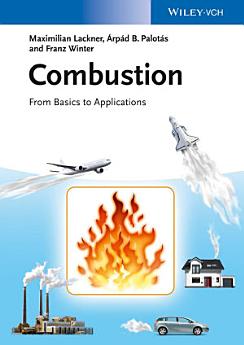Combustion: From Basics to Applications
2013 ജൂലൈ · John Wiley & Sons
5.0star
ഒരു അവലോകനംreport
ഇ-ബുക്ക്
288
പേജുകൾ
reportറേറ്റിംഗുകളും റിവ്യൂകളും പരിശോധിച്ചുറപ്പിച്ചതല്ല കൂടുതലറിയുക
ഈ ഇ-ബുക്കിനെക്കുറിച്ച്
Combustion, the process of burning, is defined as a chemical reaction between a combustible reactant (the fuel) and an oxidizing agent (such as air) in order to produce heat and in most cases light while new chemical species (e.g., flue gas components) are formed. This book covers a gap on the market by providing a concise introduction to combustion. Most of the other books currently available are targeted towards the experienced users and contain too many details and/or contain knowledge at a fairly high level. This book provides a brief and clear overview of the combustion basics, suitable for beginners and then focuses on practical aspects, rather than theory, illustrated by a number of industrial applications as examples. The content is aimed to provide a general understanding of the various concepts, techniques and equipment for students at all level as well as practitioners with little or no prior experience in the field.
The authors are all international experts in the field of combustion technology and adopt here a clear didactic style with many practical examples to cover the most common solid, liquid and gaseous fuels. The associated environmental impacts are also discussed so that readers can develop an understanding of the major issues and the options available for more sustainable combustion processes.
With a foreword by Katharina Kohse-Hoinghaus
The authors are all international experts in the field of combustion technology and adopt here a clear didactic style with many practical examples to cover the most common solid, liquid and gaseous fuels. The associated environmental impacts are also discussed so that readers can develop an understanding of the major issues and the options available for more sustainable combustion processes.
With a foreword by Katharina Kohse-Hoinghaus
റേറ്റിംഗുകളും റിവ്യൂകളും
5.0
ഒരു അവലോകനം
രചയിതാവിനെ കുറിച്ച്
Maximilian Lackner has been a lecturer on combustion at Vienna University of Technology since 2005. He studied Technical Chemistry at the same university, where he also earned his PhD degree and completed his habilitation. He obtained a Global Executive MBA from LIMAK
University in Linz, Austria. Between 2004 and 2011 he held several senior positions in the petrochemical industry in Europe and Asia. He has founded four companies and is a member of the advisory board of the VDI and an advisor to the US Department of Energy.
Prof. Arpad B. Palotas is the director of the Institute of Energy and Quality Affairs, as well as the head of the Department of Combustion Technology at the University of Miskolc, Hungary. He obtained his MSc degree in Metallurgical Engineering at the University of Miskolc and an MSc in Chemical Engineering at the Massachusetts Institute of Technology (MIT), Cambridge, MA, USA. Having completed his PhD studies at the University of Miskolc, he spent years as postdoctoral associate and visiting scientist at MIT and later at the University of Utah (Salt Lake City, UT, USA). At these institutions he continued his research on combustiongenerated aerosols, focusing on soot characterization as well
as on the development of fuel additives for the reduction of soot emission from aviation fuel sources.
Franz Winter is professor of Chemical Engineering at Vienna University of Technology, Austria. He is group leader and head of the Christian Doppler Laboratory for Chemical Engineering at High Temperatures at the Vienna University of Technology. He obtained his academic degrees from the Vienna University of Technology and has specialized in combustion and high temperature reaction kinetics. He has authored more than 300 scientific publications. He is chairman and reviewer on various scientific and technical advisory boards and an active member of the Combustion Institute.
University in Linz, Austria. Between 2004 and 2011 he held several senior positions in the petrochemical industry in Europe and Asia. He has founded four companies and is a member of the advisory board of the VDI and an advisor to the US Department of Energy.
Prof. Arpad B. Palotas is the director of the Institute of Energy and Quality Affairs, as well as the head of the Department of Combustion Technology at the University of Miskolc, Hungary. He obtained his MSc degree in Metallurgical Engineering at the University of Miskolc and an MSc in Chemical Engineering at the Massachusetts Institute of Technology (MIT), Cambridge, MA, USA. Having completed his PhD studies at the University of Miskolc, he spent years as postdoctoral associate and visiting scientist at MIT and later at the University of Utah (Salt Lake City, UT, USA). At these institutions he continued his research on combustiongenerated aerosols, focusing on soot characterization as well
as on the development of fuel additives for the reduction of soot emission from aviation fuel sources.
Franz Winter is professor of Chemical Engineering at Vienna University of Technology, Austria. He is group leader and head of the Christian Doppler Laboratory for Chemical Engineering at High Temperatures at the Vienna University of Technology. He obtained his academic degrees from the Vienna University of Technology and has specialized in combustion and high temperature reaction kinetics. He has authored more than 300 scientific publications. He is chairman and reviewer on various scientific and technical advisory boards and an active member of the Combustion Institute.
ഈ ഇ-ബുക്ക് റേറ്റ് ചെയ്യുക
നിങ്ങളുടെ അഭിപ്രായം ഞങ്ങളെ അറിയിക്കുക.
വായനാ വിവരങ്ങൾ
സ്മാർട്ട്ഫോണുകളും ടാബ്ലെറ്റുകളും
Android, iPad/iPhone എന്നിവയ്ക്കായി Google Play ബുക്സ് ആപ്പ് ഇൻസ്റ്റാൾ ചെയ്യുക. ഇത് നിങ്ങളുടെ അക്കൗണ്ടുമായി സ്വയമേവ സമന്വയിപ്പിക്കപ്പെടുകയും, എവിടെ ആയിരുന്നാലും ഓൺലൈനിൽ അല്ലെങ്കിൽ ഓഫ്ലൈനിൽ വായിക്കാൻ നിങ്ങളെ അനുവദിക്കുകയും ചെയ്യുന്നു.
ലാപ്ടോപ്പുകളും കമ്പ്യൂട്ടറുകളും
Google Play-യിൽ നിന്ന് വാങ്ങിയിട്ടുള്ള ഓഡിയോ ബുക്കുകൾ കമ്പ്യൂട്ടറിന്റെ വെബ് ബ്രൗസർ ഉപയോഗിച്ചുകൊണ്ട് വായിക്കാവുന്നതാണ്.
ഇ-റീഡറുകളും മറ്റ് ഉപകരണങ്ങളും
Kobo ഇ-റീഡറുകൾ പോലുള്ള ഇ-ഇങ്ക് ഉപകരണങ്ങളിൽ വായിക്കാൻ ഒരു ഫയൽ ഡൗൺലോഡ് ചെയ്ത് അത് നിങ്ങളുടെ ഉപകരണത്തിലേക്ക് കൈമാറേണ്ടതുണ്ട്. പിന്തുണയുള്ള ഇ-റീഡറുകളിലേക്ക് ഫയലുകൾ കൈമാറാൻ, സഹായ കേന്ദ്രത്തിലുള്ള വിശദമായ നിർദ്ദേശങ്ങൾ ഫോളോ ചെയ്യുക.







